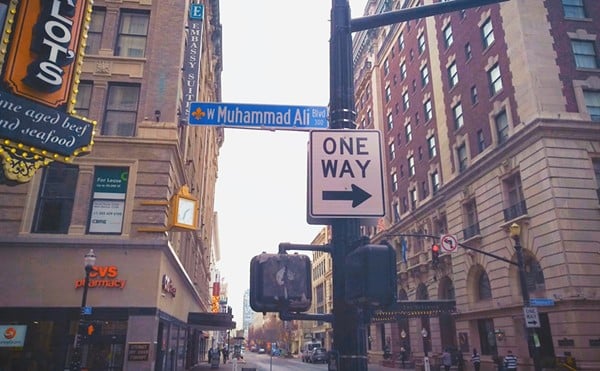The young boy was sitting across the table from me, and he seemed to be a kind of shapeshifter vacillating between willingness and reluctance.
I and another volunteer were talking with the young man and his mother at a local library in as part of Restorative Justice Louisville, or RJL.
This was a first step toward, hopefully, keeping him out of the court system.
For that to happen, however, the young boy needed to accept responsibility for his actions and agree to make amends for the harm he had caused. He was accused of making prank calls to the police in which he reported shootings in his neighborhood. And he denied he did it.
Having done several such sessions, his shapeshifting alarmed me.
The middle-schooler was attentive during most of the meeting. He looked me in the eye when I spoke, which is uncommon for most young adults these days, let alone someone still in middle school. He was an engaging, handsome boy with the lean body of an athlete, but when I asked him if played sports he answered he didn’t. He preferred math.
Then, like a storm cloud rolling in over the horizon, his demeanor morphed. As we discussed his crime and tried to extract details of his reasoning for committing it, his head dropped. He stopped talking.
SAVING LIVES
RJL brings together the offender, victim and community to provide justice, but do so, if possible, without a jail or prison term. A key to its success is a facilitated process that is centered on making things right for all involved while enabling creative solutions normally not used within the traditional justice system, such as:
• Paying restitution for property damage but having the amount reduced every time the young person attends a specific program;
• The victims volunteering to do community service with the young person so they could get to know each other better; or
• For example, a victim assisting the young person, who had an interest in computers, to work on computers to help pay his restitution.
RJL received referrals for 152 young people in 2017. As RJL is currently providing a diversion option, the referrals sent to RJL involve young people who are eligible and have committed types of offenses. These generally are misdemeanor and low level felony offenses.
Jefferson County Circuit Court Judge Angela Bisig strongly supports RJL. “Handling crimes using Restorative Justice allows the offending youth to see their victim as a person and realize the full impact of their actions. Allowing them to be part of the plan to fix the harm they caused empowers them to rejoin the community as a productive member,” she said.
Through facilitated conferences, all involved collectively identify harm and determine a way forward that is centered on healing. Using the restorative justice approach works to ensure that compassion and restitution are integral parts of the judicial process.

This process is dramatically different from the traditional criminal justice system, which asks what laws have been broken and what punishment is deserved by the offender. Restorative justice asks what harm has been done, who is responsible for repairing that harm, and how can that harm be repaired?
Participation in restorative justice programs is voluntary for all participants. It involves a basic, three-step process: first, a meeting with the person charged and his or her support persons; then, a meeting with the person who was harmed and their support person; and, finally, a meeting of all the people impacted by the incident.
RJL has more than a 60% successful completion rate for all the cases referred from the justice system. Completion is defined as the young person finishing the conference agreement, which is what they agreed to do to make amends. Much like other restorative justice programs, RJL has shown significant positive outcomes for those who participated in the conference process. For example, RJL completed a study regarding recidivism, and RJL defined recidivism as a new conviction within one year of case closure. Those youths who successfully completed the restorative justice conference process had a 23% recidivism rate, as compared to 56% for those who did not complete the conference process. Preventing youth from further involvement in the juvenile justice system helps them avoid becoming involved in the “deep end” of the juvenile justice system and maintain connectedness and engagement in their community.
In the case of the young boy, his mother had bought into the program, and she was an eager and engaged participant. She clearly knew what was at stake. Though the prank calls seemed minor, the charge could be enough to leave him with a criminal record. Nonetheless, it was not clear if he cared what could happen to him. Sometimes it appeared he was concerned, and other times it seemed he did not have the slightest interest in the outcome.
However, he should have been very worried.
A story by the Kentucky Center for Investigative Reporting in June 2018 by Kate Howard makes the consequences crystal clear: “Three of Every Four Jailed Louisville Youth are Black: Who Can Change That?”
“… The black population — and police enforcement — is concentrated in the neighborhoods of West Louisville. Though black youth are less than 27% of Louisville’s population, they represented more than 75% of the youth bookings in the city’s secure facility last year.”
Beth McMahon, chief juvenile defender at the Louisville Metro Public Defender Corp., told Howard that, “It’s not that black youth commit more crime and therefore that’s why they’re in the system. ... They are treated differently from the beginning, a lot of times.”
The young man featured in Howard’s story ended up in prison after a string of escalating offenses that began with disorderly conduct and possession of tobacco at 13. Once deemed a troublemaker by police, he became a target for law enforcement.
So, in the case of this young boy, if this preconference and subsequent conference with the police officer did not go well, he could be on that same path into the correctional industrial complex, which churns out hardened criminals who are likely to repeatedly return to incarceration or end up dead.
To that point, Libby Mills, RJL’s executive director, explained, “RJL offers an alternative for young people such as the young boy — but also for Kentucky. The state spends more than $19,000 per year to house an adult inmate, but only $7,000 to educate a child. And it costs even more to house a juvenile each year, at around $72,000 — making it cheaper to send a kid to college for four years than to juvenile detention for one year.”
HOW IT WORKS
RJL uses a co-facilitation model, which assigns at least two facilitators for every restorative justice conference. Jeff was my co-facilitator. He is a kind and thoughtful man who is passionate about helping his community.
When I asked Jeff why he chose to volunteer as a RJL facilitator, he said,
“I saw the restorative justice process as a way to give a voice to the person harmed. The harmed person can talk about the impact of the youth’s behavior and how their daily routine may have changed, due to the youth’s actions. A face to face discussion with the young person on how to repair the harm caused can help bring closure for the person harmed.”
I told him I thought that was an interesting perspective because I never considered it from the victims side.
He added, “I also liked that the RJ process was truly a learning experience and a life lesson for young people. They begin to gain an understanding of how their actions/behavior impact the people around them and the community in which they live. They deal with and learn about accountability. They experience how to own their actions. Different from the court system, the RJ process does not punish the young person[s]. It takes the young person through the process of repairing the harm that was caused and making things right with the person harmed.”
Like every facilitator, I joined the program after learning about RJL’s purpose so I could do my part to end this cycle. However, it is not something you choose to do and then just show up. Serving as a RJL facilitator requires attendance in a comprehensive training and certification process before beginning to facilitate conferences.
Mills said the process to become a volunteer facilitator involves meeting with her or her staff for an initial interview and then attend four days of training. “Once they complete the training they will be mentored by staff or experienced facilitators until they are ready to co-facilitate on their own,” she said.
Our job was to use the skills we learned, such as motivational interviewing, active listening, conflict resolution and trauma-informed approaches for engaging the participants in the restorative justice conferences. We took part in hours of role-playing exercises to prepare us for the conferences we would eventually facilitate. However, our primary job was to keep the conference focused by asking affective and open-ended questions, not being active participants.
THE ALIBI
The young boy said he was at a friend’s house for a sleepover with several other teenagers. He explained he went to bed and left his cell phone in the living room. He woke up several hours later when the police came to the door.
The officers had determined phone calls had come from that home. They explained to the parent of the house several dozen calls were made to the police headquarters stating that shots were being fired in the neighborhood. When the cell numbers were checked, it was determined the calls came from his phone.
He was adamant he did not place the calls. His friends denied they had used the phone.
With no other recourse, the officer put him in the patrol car, took him to his home and released him to his mother. He was later charged, but the court decided to refer the case to RJL. Fortunately for him, he and this offense were eligible for referral to RJL.
It was during the next phase of the pre-conference meeting when he shapeshifted. He became very agitated and even aggressive when any notion of him taking responsibility for the action was addressed. He kept repeating, “It was not my fault. I didn’t make the phone calls.”
His mother tried to reason with him and told him that maybe he should have been more careful with his cell phone.
He wouldn’t budge.
He did acknowledge the harm that had been done to his mom, who had to take off work to transport him to various meetings (the mother made sure her child’s impact on her life was made abundantly clear).
Without the recognition of harm and acceptance of responsibility, it can be difficult to go to the next step — the final conference. But we saw he was able to understand how his involvement in this incident had impacted his mother, so we knew he would be able to listen to others he had harmed, learn, and understand how he had impacted them. Luckily for us, as volunteer facilitators, RJL is always available to assist us. They helped us consider how to most effectively assist youth like the young boy and his mother through the conference process.
Fortunately, he and his mother agreed to meet with one of officers involved the night of the incident. This officer had already agreed he would represent the community, not as one specific person impacted by the incident, but rather as a whole neighborhood.
Jeff and I hoped the time between the conference meetings would allow the young man enough time to reflect on and admit what he did. We hoped desperately he would come around when meeting with the police officer.
The most powerful nature of the restorative justice process is when the victim and offender meet to discuss what happened and how the incident impacted everyone.
Jeff and I encouraged the youth to think about what was discussed and come to the upcoming final conference meeting with an open mind. The earnest youth then appeared again before our eyes. We all shook hands and departed the conference room.
THE SURPRISE
The following week, Jeff and I met at a Louisville Metro Police Department’s division headquarters in West Louisville for the final conference. We saw an officer in uniform get out of his car and walk toward us. He moved with a purpose. His bullet-resistant vest, under his uniform, gave him an even more formidable appearance. He shook our hands with a vice grip and spoke in a tone incongruent with his appearance. He introduced himself in a calm, almost-soft voice, “I’m Simon Franklin.”
He said he had never participated in the restorative justice process, but he thought it was a fitting way to handle this kind of situation. He described what happened and the impact it had on not only him, but other members of the LMPD and the community at large. It was a compelling story — I had no idea how much a prank call could affect so many of our law enforcement men and women.
When he finished, Jeff and I explained the situation with him — his reluctance to admit wrongdoing and take responsibility for his actions. We were at a complete impasse, and the only way we can get to closure was if he could lead the young man to understanding.
We also informed the officer of the young boy’s changing behavior, shapeshifting during the pre-conference meeting.
He smiled and said, “I got this.”
The mother and the boy arrived, and we all sat down around a table.
The youth presented the amiable version of himself and was respectful to Officer Franklin.
Jeff established the ground rules of the session. First, everyone agreed to attend the restorative justice conference process voluntarily. The meeting could be stopped at any time, and breaks were encouraged if anyone needed them. Second, everyone would be treated with respect. And, finally, everything that was said in the meeting was confidential. [Ed. note: Names, ages and some details were left out of this story to preserve the participants’ anonymity.]
We had determined the young boy would speak first and talk about what happened and describe the harm he thought had been done. He detailed the events just as he did in the pre-conference. His mother spoke and related how she had been significantly inconvenienced, particularly the adverse effect it had on her job.
It was now Officer Franklin’s turn.
I turned my attention to the young boy. His head dropped. The first sign of the morphing. I panicked a little, but held my breath and resisted the urge to speak. I had interjected myself in the process once before (even though it was explicitly against my training) and it did not turn out well. I would not repeat that mistake and silently prayed.
Officer Franklin spoke in his even-toned manner. This brought the young boy’s head up slowly until it was erect and the officer’s eyes and demeanor captivated the young man’s attention.
Officer Franklin explained to him he had been on a call to respond to an accident in which a car had overturned and a young woman was hurt and trapped. It was a desperate situation. However, a high alert came over the radio, signaling a serious crime was being committed. In this case it was shots being fired.
Several members of the responders to the accident, including Officer Franklin, who had been the first on the scene, had to leave and drive fast to where the shootings were reported. Only a couple officers were left at the crash to continue trying to extract the women.
His eyes remained focused on Officer Franklin, sometimes he even squinted.
Officer Franklin then explained the danger of driving at fast speeds. He told the young boy that sometimes they result in wrecks. Moreover, the fact several calls (that later turned out to be pranks) were being placed directing police to different locations throughout the neighborhoods resulted in officers not being available for where they were needed, including the crash site.
It was clear the young boy was moved by Officer Franklin’s story.
Without provocation, he said he had no idea how many people prank calls could affect. This was a momentous step. He acknowledged harm had been done to people, other than to his mother.
However, the most important part of the conference remained — his taking responsibility for the action and his willingness to make amends. The young boy had resisted any notion he had done anything wrong.
I was formulating a plan in my mind on how to generate this discussion, when Officer Franklin thankfully preempted me.
What happened next was magical.
The policeman said, “I believe you didn’t make those calls.”
This took the young boy totally off guard.
“But, my man, that doesn’t let you off the hook. Your mom paid a lot of money for that cell phone. Don’t you think you should have secured it?”
Still looking in the officer’s eyes, he nodded yes.
“And what about those so-called friends of yours. They don’t sound like good people to me. They threw you under the bus. Don’t you think you should be more careful with who you hang out with?”
He nodded yes again.
“So, don’t you think you have at least some responsibility for what happened?”
“Yeah, I messed up. I’m not hanging out with those guys anymore and I’ll always keep my cell phone with me.”
He looked at Officer Franklin and asked, “What do I need to do to make this right?”
The officer shifted a bit in his chair and leaned forward toward the young boy and asked, “Did you learn your lesson?”
“Yes sir.”
“Then, we are all good,” Officer Franklin said.
After saying our goodbyes, Jeff and I met outside the station. We talked and marveled at what we saw transpire between the young boy and Officer Franklin. It would be a beautiful thing if this opportunity was available to every young man and woman who missteps along the way.
I think maybe there should be some serious shapeshifting in our justice system. •






